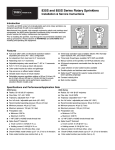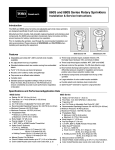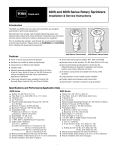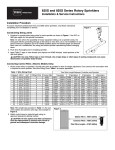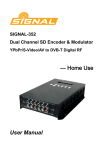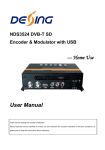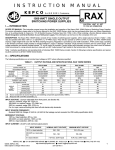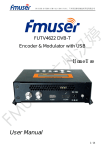Download Toro DT34 User's Manual
Transcript
DT34 and DT54 Series Rotary Sprinklers Installation & Service Instructions Note: For preliminary use only. Introduction ______________________________________________________________________ The DT34 and DT54 series full-circle rotary sprinklers are designed specifically for golf course applications. OFF AU TO Manufactured from durable, high-strength engineering plastic and stainless-steel components, these sprinklers incorporate many innovative and time-proven features for lasting, maintenance-free operation. ON Prior to installing the sprinkler, read through the recommended installation and start-up procedures. Please observe all WARNINGS and CAUTIONS when installing and operating this equipment. DT34 Electric Valve-In-Head DT54 Electric Valve-In-Head Features _______________________________________________________________________________ ■ Main nozzle trajectory allows for 25 and 15 degree selections ■ Three body thread types available: NPT, BSP and ACME ■ Full 4" (10,1 cm) pop-up clears tall grasses ■ Manual sprinkler control, On-Off-Auto (electric models only) ■ Nozzles color-coded by radius and gallonage ■ ■ Cap serves as an effluent water indicator ■ Variable stators Bowl-vented discharge (atmospheric) minimizes the differential pressure required for regulation and ensures positive valve closure (electric models only) ■ Selectable pressure regulation settings of 50 psi (3.4 bar), 65 psi (4.5 bar), 80 psi (5.5 bar) or 100 PSI (6.9 bar) to ensure consistently accurate nozzle performance regardless of elevation (electric models only) ■ All internal components serviceable from the top of the sprinkler ■ Large selection of color-coded nozzles available ■ Durable plastic and stainless-steel construction ■ Optional radius reduction screw ■ Three body activation types available: Electric VIH, Normally Open Hydraulic VIH, and Check-O-Matic Specifications and Performance/Application Data _______________________________________ DT34 Series ■ ■ ■ ■ ■ ■ ■ ■ ■ ■ ■ ■ ■ ■ ■ Radius: 52'–92' (15,9–28,0 m) Flow Rate: 15–50 GPM (56,7–189,3 LPM) Trajectory: Selectable 15° or 25° Arc: Full Circle Recommended Operating Pressure: 65–100 PSI (4,5–6,9 Bar) Minimum Pressure: 40 PSI (2,8 Bar) Maximum Pressure: 150 PSI (10,3 Bar) Precipitation Rate: ■ Minimum: 0.46"/hr (11,7 mm/hr) ■ Maximum: 0.63"/hr (16 mm/hr) Body Height: 10" (25.4 cm) Pop-Up Height: 4.1875" (10.6 cm) Inlet Size: 1" NPT, BSP or ACME Electric Valve-in-head Solenoid: ■ Inrush current: 0.30A @ 24 VAC, 50/60 Hz ■ Holding current: 0.20A @ 24 VAC, 50/60 Hz Manual Control (Electric VIH only): On-Off-Auto Check-O-Matic model checks up to 37' (11,2 m) of elevation. Seven Nozzle Variations: See chart on page 2. DT54 Series ■ ■ ■ ■ ■ ■ ■ ■ ■ ■ ■ ■ ■ ■ ■ Radius: 52'–100' (15,9 m–30,5 m) Flow Rate: 15–62 GPM (56,8–234,7 LPM) Trajectory: Selectable 15° or 25° Arc: Full Circle Recommended Operating Pressure: 65–100 PSI (4,5–6,9 Bar) Minimum Pressure: 40 PSI (2,8 Bar) Maximum Pressure: 150 PSI (10,3 Bar) Precipitation Rate: ■ Minimum: 0.50"/hr (12,7 mm/hr) ■ Maximum: 0.72"/hr (18,3 mm/hr) Body Height: 11" (27.9 cm) Pop-Up Height: 4.1875" (10.6 cm) Inlet Size: 1.5" NPT, BSP or ACME Solenoid: ■ Inrush current: 0.30A @ 24 VAC, 50/60 Hz ■ Holding current: 0.20A @ 24 VAC, 50/60 Hz Manual Control (Electric VIH only): On-Off-Auto Check-O-Matic model checks up to 37' (11,2 m) of elevation. Nine Nozzle Variations: See chart on page 2. DT34 Series Sprinkler Performance Data Nozzle Set Base 31 ● (Yellow) Pressure ★ BLUE psi Radius 50 65 80 100 56 58 61 63 Nozzle Set 32 ● (Blue) ■ YELLOW ★ RED Nozzle Set 33 ● (Brown) ■ YELLOW ★ RED ■ YELLOW Nozzle Set 34 ● (Orange) ★ BEIGE ■ GPM Radius GPM Radius GPM Radius 13.2 15.0 16.5 18.4 16.6 20.0 22.1 24.7 64 66 70 74 22.3 25.0 27.4 30.3 65 70 73 76 60 62 66 71 YELLOW Nozzle Set 35 ● (Green) ★ BIEGE ■ YELLOW Nozzle Set 36 ● (Gray) ✪ RED GPM Radius GPM Radius 27.4 30.0 33.2 37.0 35.0 38.4 42.5 84 87 75 78 81 ■ YELLOW Nozzle Set 37 ● (Black) ✪ GRAY ■ YELLOW GPM Radius GPM 41.0 46.0 45.0 49.5 87 90 Radius shown in feet. Toro recommends the use of a 11⁄4" (30mm) swing joint at flows over 25 GPM (95 LPM). Sprinkler radius of throw per ASAE standard S398.1 ● = Main Nozzle ★ = Intermediate Nozzle ✪= Intermediate Nozzle w/ Straightener ■ = Inner Nozzle (Yellow w/ Yellow Restrictor) All sprinklers are equipped with the selectable pilot valve that allows settings at 50, 65, 80 and 100 psi. DT54 Series Sprinkler Performance Data Nozzle Set Base 51 ● (Yellow) Pressure Nozzle Set Nozzle Set Nozzle Set Nozzle Set Nozzle Set Nozzle Set 52 ● (Blue) 53 ● (Brown) 54 ● (Orng) 55 ● (Green) 56 ● (Gray) 57 ● (Black) ★ BLUE ■YELLOW ★ RED ■YELLOW ★ RED ■YELLOW ★ BEIGE ■YELLOW ★ BEIGE ■YELLOW psi 50 65 80 100 13.2 15.0 16.5 18.4 60 16.6 62 20.0 66 22.1 71 24.7 Low-flow Stator 64 66 70 74 22.3 25.0 27.4 30.3 65 70 73 76 27.4 30.0 33.2 37.0 75 78 81 Nozzle Set 59 ● (Beige) ✪ RED ■YELLOW ★BRN ✪GRY ■YLW ★BRN ✪GRY ■YLW ✪ GRAY ■YELLOW Radius GPM Radius GPM Radius GPM Radius GPM Radius GPM Radius GPM Radius GPM 56 58 61 63 Nozzle Set 58 ● (Red) 35.0 38.4 84 41.0 87 42.5 87 46.0 90 Medium-flow Stator 45.0 49.5 Radius GPM 90 95 52.0 56.5 94 57.5 100 62.0 High-flow Radius shown in feet. Toro recommends the use of a 11⁄4" (30mm) swing joint at flows over 25 GPM (95 LPM). Sprinkler radius of throw per ASAE standard S398.1 ● = Main Nozzle ★ = Intermediate Nozzle ✪= Intermediate Nozzle w/ Straightener ■ = Inner Nozzle (Yellow w/ Yellow Restrictor) All sprinklers are equipped with the selectable pilot valve that allows settings at 50, 65, 80 and 100 psi. Sprinkler Spacing Guidelines ❚ Square Spacing Precipitation Rate Formulas ❚ No wind - 55% of diameter 4 mph wind - 50% of diameter 8 mph wind - 45% of diameter ❚ GPM of full circle x 96.3 (Spacing)2 Triangular Spacing No wind - 60% of diameter 4 mph wind - 55% of diameter 8 mph wind - 50% of diameter ❚ Square-spaced sprinklers in pattern: ❚ GPM of full circle x 96.3 (Spacing)2 (0.866) Single-Row Spacing No wind - 50% of diameter 4 mph wind - 50% of diameter 8 mph wind - 45% of diameter ❚ Note: Designing for zero (0) mph wind conditions is not recommended. Design for worst wind conditions. For additional information, refer to Toro Technical Data Manual, form number 490-1737. Triangular-spaced sprinklers in pattern: Area and flow: Total GPM of zone x 96.3 Total irrigated square feet of zone ❚ Single row: GPM of full circle x 96.3 (Spacing) (Scallop) 2 Installation Procedure ___________________________________________________ To assure maximum performance from your 800S series sprinklers, read these instructions completely prior to installation or service. OFF AU TO Figure 1 ON Constructing Swing Joints 1. Construct or provide triple swing joints for each sprinkler as shown in Figure 1. Use PVC or ABS pipe nipple for the sprinkler connection. Note: On sites where the possibility of heavy equipment rolling over a sprinkler exists, the swing joint will flex preventing damage to the lateral or main lines. On a new installation in raw ground where the sprinklers are to be initially installed above the finished grade and lowered when new turf is established, the swing joint allows sprinkler repositioning without changing risers. This is a common and practical procedure which eliminates the problem of dirt being accidentally introduced into the lateral lines when a riser is changed. 2. Flush lines thoroughly prior to installing sprinkler. 3. Apply PTFE tape on riser threads (not required on ACME threads). Install sprinkler to riser and tighten. CAUTION: Use only PTFE tape on riser threads. Use of pipe dope or other types of sealing compounds can cause deterioration of sprinkler body threads. Connecting Control Wires (Electric Models Only) 1. Route control wires to sprinklers. Provide extra wire at sprinkler to allow for height adjustment. One common wire and station wire is required for each sprinkler. See Wire Sizing Chart, Table 1 for proper application. Note: Wire length data provided in Table 1 is the sum of the station and common wire legs. See example in Figure 2. Table 1: Wire Sizing Chart Voltage 23 23 23 23 23 23 23 24 24 24 24 24 24 24 AWG 14/14 14/12 14/10 12/12 12/10 12/8 10/10 14/14 14/12 14/10 12/12 12/10 12/8 10/10 mm2 2.5/2.5 2.5/4.0 2.5/5.5 4.0/4.0 4.0/5.5 4.0/7.0 5.5/5.5 2.5/2.5 2.5/4.0 2.5/5.5 4.0/4.0 4.0/5.5 4.0/5.5 10/10 Voltage Drop Circular Mils 4 4100 4 5315 4 7250 4 6530 4 8465 4 11515 4 10400 5 4100 5 5315 5 7250 5 6530 5 8465 5 11515 5 10400 Total Wire Length Between Controller and Sprinkler 1 Sprinkler 2 Sprinklers 3 Sprinklers 4 Sprinklers 3285' 1001 m 1642' 500 m 1095' 334 m 821' 250 m 4259' 1298 m 2129' 649 m 1419' 432 m 1064' 324 m 5809' 1770 m 2904' 885 m 1936' 590 m 1452' 443 m 5232' 1595 m 2616' 797 m 1744' 531 m 1308' 399 m 6783' 2067 m 3391' 1033 m 2261' 689 m 1695' 517 m 9227' 2812 m 4613' 1406 m 3075' 937 m 2306' 703 m 8333' 2540 m 4166' 1270 m 2778' 846 m 2083' 635 m 4106' 1251 m 2053' 626 m 1369' 417 m 1026' 313 m 5323' 1622 m 2662' 811 m 1774' 541 m 1331' 406 m 7261' 2213 m 3631' 1106 m 2420' 738 m 1815' 553 m 6540' 1993 m 3270' 996 m 2180' 664 m 1635' 498 m 8478' 2584 m 4239' 1292 m 2826' 861 m 2119' 646 m 11533' 3515 m 5766' 1757 m 3844' 1172 m 2883' 879 m 10416' 3175 m 5208' 1587 m 3472' 1058 m 2604' 790 m Figure 2 2. Attach control wires to solenoid leads using an approved waterproof splicing method. CAUTION: All wire splices and field connections must be waterproofed to prevent short circuit to ground and subsequent controller damage. Station Wire = 1095' (334m) Common Wire = 1095' (334m) Connecting Hydraulic Control Tubing Total Wire Length = 2190' (668m) 1. Route control tubing from the controller to the sprinkler location(s). Note: Leave an 18" (45.7 cm) service loop of tubing at each sprinkler to facilitate movement of sprinkler and service operations. Refer to Table 2 for tubing run length and sprinkler elevation information. Table 2: Hydraulic Control Systems Type of System* 2. Flush tubing thoroughly to remove all air and debris. 3. Remove the tube retainer and poly cap from the tubing adapter at the base of the sprinkler. 4. Slide the tube retainer over the end of the control tubing and attach tubing to adapter. 5. Slide tube retainer over adapter area to secure tubing. * Maximum Distance From Controller Elevation Restrictions Normally Open (01) with 3/16" Control Tubing 500' Valve elevation should not exceed 25' ABOVE controller elevation or 70' BELOW controller elevation. Normally Open (01) with 1/4" Control Tubing 1000' Valve elevation should not exceed 25' ABOVE controller elevation or 70' BELOW controller elevation - All hydraulic connections on Toro valves are 1⁄4" insert type. - Control line pressure must be equal to or greater than mainline pressure. - Control line pressure range is 40 to 150 PSI. 3 System Start Up _________________________________________________________ The following is a recommended procedure that will protect system components during system start-up. The procedure is based on a velocity fill rate of less than 2' (.61 m) per second. See Table 3 below. Table 3: Recommended System Fill Rate Pipe Size in. 1/2 3/4 1 1-1/4 1-1/2 2 2-1/2 cm 1.3 1.9 2.5 3.1 3.8 5.0 6.4 Flow GPM 2 3 5 10 10 20 30 LPM 7.6 11.4 18.9 37.9 37.9 75.7 113.6 Velocity ft/sec 1.60 1.92 1.50 1.86 1.41 1.80 1.84 m/sec 0.49 0.59 0.46 0.57 0.43 0.55 0.56 Pipe Size in. 3 4 6 8 10 12 cm 7.6 10.1 15.2 20.2 25.4 30.5 Flow GPM 45 75 150 250 450 500 Velocity LPM 170.3 283.9 567.8 946.3 1703.0 1893.0 ft/sec 1.86 1.87 1.73 1.70 1.97 1.55 m/sec 0.57 0.57 0.53 0.52 0.60 0.47 WARNING NEVER STAND OR LEAN OVER THE SPRINKLER WHILE THE IRRIGATION SYSTEM IS BEING FILLED, DURING MANUAL OR AUTOMATIC OPERATION OR WHEN PERFORMING SPRINKLER SERVICE PROCEDURES. DIRECT CONTACT WITH IRRIGATION SPRAY, A FAILED OR IMPROPERLY INSTALLED SPRINKLER CONNECTION OR SPRINKLER COMPONENTS FORCIBLY EJECTED UPWARD UNDER PRESSURE CAN CAUSE SERIOUS INJURY. 1. Use a jockey pump only to fill the system at a velocity fill rate of less than 2' (0.61 m) per second. CAUTION: Failure to comply with recommended fill rate will increase line pressure resulting in a water hammer effect that could damage sprinklers and piping components. See Warning above. 2. At all tees and greens use quick coupler keys with quick coupler valves to bleed air from the system lines during the filling process. For best results, do not compress air and then relieve it – bleed the air constantly while filling the system. 3. After water has filled all lines and all air is removed, remove the quick coupler keys. Pilot Valve Operation (Electric Models Only) ________________________________________ The pilot valve controls the operation of the main valve located in the base of the sprinkler body. The main valve is operated by the release Figure 3 of water metered through the pilot valve when it is activated either manually at the sprinkler or by the irrigation system controller. The sprinkler operation mode is set using a Toro Selector Tool (P/N 995-15) inserted through the body flange onto the pilot valve D-shaped selector cam. The "AUTO" mode permits automatic operation from the system controller. The "ON" mode opens the main valve for manual operation and "OFF" mode prevents the main valve from opening. The pilot valve regulates the water pressure to the sprinkler nozzle. Pressure regulation compensates for large variations within the system and maintains a constant pressure for optimum sprinkler operation. The pilot valve is factory set to regulate one of four pressure levels: 50 psi (3.4 bar), 65 psi (4.5 bar), 80 psi (5.5 bar) or 100 PSI (6.9 bar). Change the pilot valve operating pressure by loosening the thumb screw that secures the selector lever. Position the selector lever to the desired operating pressure and hand-tighten the nut. See Figure 3. 4 100 PSI (7.0 kg/cm2) 80 PSI (5.6 kg/cm2) 65 PSI (4.6 kg/cm2) 50 PSI (3.5 kg/cm2) Nozzle Trajectory Adjustment Procedure _______________________________________ Note: The nozzle trajectory is factory pre-set at 25 degrees. 1. Insert the multi-purpose tool (P/N 995-83) into the slot provided in the top of the cap. Pull the riser assembly up, then grasp the assembly to hold it in the popped-up position. 2. Remove the cap retaining screw and cap. 3. Using a 5/8" nut driver (P/N 995-99), turn the nozzle/housing assembly left to select 15° trajectory as shown in Figure 4. Turn the nozzle/housing assembly right to select 25° trajectory as shown in Figure 5. 4. Install the cap making sure the top the nozzle housing is correctly nested in the cap. 5. Install the cap retaining screw. 6 Activate the sprinkler to check the spray trajectory. Figure 5 Figure 5 5 Troubleshooting _________________________________________________________ ■ Pilot Valve Possible equipment failures with causes and corrective action are listed below. PROBLEM SPRINKLER WILL NOT TURN ON SPRINKLER WILL NOT SHUT OFF ■ Sprinkler Assembly POSSIBLE CAUSE – CORRECTIVE ACTION (a) No 24 VAC to coil assembly. (Electric Models) – Measure voltage with a Digital Volt Meter (DVM). Check wiring and controller program. – Refer to Controller Operating Instructions. (b) Selector cam in "OFF" position. – Set to "AUTO" position. (c) Debris in pilot valve assembly. – Disassemble and remove all debris. (See Servicing Pilot Valve page 11.) (d) Insufficient pressure in controller supply line and/or sprinkler control tube. (N.C. Models) – Check pressure. (a) Constant 24 VAC from controller. (Electric Models) – Check for voltage using a DVM. If voltage is present, disconnect wire. If sprinkler closes, service controller. Refer to Controller Service Manual. (b) Selector cam in manual "ON" position. – Set to "AUTO" or "OFF" position. (c) Debris in pilot valve assembly. – Disassemble and remove all debris. (See Servicing Pilot Valve page 11.) (d) Constant pressure from controller. (N.C. Models) – Check pilot valve at controller for constant flow. – Check elevation differential. Valve elevation should not exceed 0' above controller elevation or 70' (21.3 m) below controller elevation. PROBLEM SPRINKLER WON'T ROTATE HEAD STICKS UP POOR DISTRIBUTION PATTERN ■ Main Valve PROBLEM VALVE WON'T CLOSE (Electric ) POSSIBLE CAUSE – CORRECTIVE ACTION (a) Debris wedged between stator and turbine. – Remove obstruction. (b) Drive assembly defective. – Replace drive assembly. (c) Nozzle base assembly defective. – Replace nozzle base assembly. (a) Dirt in riser assembly. – Flush out. (See Flushing Procedure on page 11.) (b) Damaged or missing return spring. – Replace. (c) Damaged riser. – Replace. (a) Nozzle plugged with debris. – Clean or replace nozzle. (b) Nozzle orifice damaged. – Replace nozzle. (c) Low operating pressure. – Determine why system overloaded and correct. POSSIBLE CAUSE – CORRECTIVE ACTION (a) Continuous 24 VAC to sprinkler. – Check controller for voltage source. (b) Leak in pilot valve assembly. – Replace pilot valve assembly. (c) Plugged supply screen on piston. – Clean or replace screen. (d) Manual control selector on pilot valve assembly turned to "ON" position. – Turn to "AUTO" position. (e) Plunger movement restricted. – Inspect and clean or replace. (f) Valve cylinder misaligned with sprinkler body communication tube. – Remove valve assembly and install correctly. (g) Foreign object keeping valve from seating. – Remove, clean and check valve for damage. Replace if necessary. (h) Damaged piston seal or piston assembly. – Replace valve assembly. 6 VALVE WON'T CLOSE (Hydraulic) (a) (b) (c) (d) (e) VALVE WON'T OPEN (Electric) (a) (b) (c) (d) (e) (f) (g) VALVE WON'T OPEN (Hydraulic) (a) SPRINKLER WEEPING (Slow leak in valve) (a) (b) (c) (d) SEVERAL VALVES ON DIFFERENT STATIONS FAIL TO CLOSE (Hydraulic) (a) (b) (c) (d) Leak in control tubing. – Isolate and repair. Pilot valve leak in controller. – Confirm by observing constant dripping from discharge line of controller. Refer to Controller Service Manual. Valve cylinder misaligned with sprinkler body communication tube. – Remove valve assembly and install correctly. Foreign object keeping valve from seating. – Remove, clean and check valve for damage. Replace if necessary. Damaged piston seal or piston assembly. – Replace valve assembly. Control (field) wires severed. – Isolate and repair. No power to controller. – Establish controller power. No power from controller to solenoid. – Check for blown fuse and replace. Manual control selector on pilot valve assembly turned to "OFF" position. – Turn to "AUTO" position. Pilot valve solenoid inoperative. – Remove and replace. Pilot valve plunger movement restricted. – Inspect, clean and/or replace. No supply from main valve. – Debris in control tube, main valve assembly and/or communication passages in body. Flush thoroughly. Plugged controller discharge line or discharge port in pilot valve. – Verify by checking for discharge at discharge line when station is activated. If no discharge, refer to Controller Service Manual. Damaged or blocked valve seat. – Remove blockage and, if necessary, replace valve assembly. Damaged piston seal or piston assembly. – Replace valve assembly. Low pressure on supply line . – Check for low pressure reason and correct. Elevation of normally closed sprinkler exceeds 75' (22.9 m) differential. Control tubing leak which lowers supply pressure to other stations. – Turn controller from station to station until a station is reached where only valves on that station stay open. The leak would be in the tubing on that station. Isolate and repair. Leak in supply line to controller. – Verify by checking pressure in all control lines. Leak in controller pilot valve. – Verify by constant discharge from controller. Plugged supply line filter. – Replace filter if more than 3 psi (0.21 bar) differential exists. 7 Servicing Procedures ____________________________________________________ The DT series sprinklers are designed to provide the user trouble-free operation for many years without scheduled maintenance. If it becomes necessary to disassemble the sprinkler to correct a malfunction or replace a component, all internal parts of the sprinkler can be accessed from the top. Refer to the Troubleshooting Procedure in this manual in the event of a malfunction. Some special tools are required for disassembly and/or maintenance of the sprinkler and are available from your Toro dealer. Servicing Sprinkler Mechanism WARNING NEVER STAND OR LEAN OVER THE SPRINKLER WHILE THE IRRIGATION SYSTEM IS BEING FILLED, DURING MANUAL OR AUTOMATIC OPERATION OR WHEN PERFORMING SPRINKLER SERVICE PROCEDURES. DIRECT CONTACT WITH IRRIGATION SPRAY, A FAILED OR IMPROPERLY INSTALLED SPRINKLER CONNECTION OR SPRINKLER COMPONENTS FORCIBLY EJECTED UPWARD UNDER PRESSURE CAN CAUSE SERIOUS INJURY. Note: Refer to Figure 6 for the following procedure: 1. Insert hooked end of multi-purpose tool (P/N 995-83) into slot provided in top of cap (3). Pull assembly upward, grasp and hold in position. Figure 6 2. Insert hooked end of multi-purpose tool into slot in snap ring (11). Pull snap ring inward toward the sprinkler assembly, then upward to remove from the snap ring groove in sprinkler body. Pull riser assembly out of sprinkler body. 3. Use a 5/8" nut driver (P/N 995-99) to unscrew main nozzle (10). 4. Remove cap screw (1) and cap (3). 5. Grasp return spring (14) and riser (16) firmly and hold in place while removing nozzle base (4). Turn nozzle base assembly counterclockwise to remove. 6. Carefully release tension from return spring (14). 7. Remove spring and seal retainer/o-ring assembly (12 and 13). 8. Remove o-ring (13). 9. Remove rock screen (19) turning it counterclockwise with edge of multi-purpose tool or tips of snap ring pliers (P/N 995-100). 10. Remove drive assembly (17) and stator (18) from riser assembly by carefully pressing on end of threaded shaft. 11. Using a 5/16" nut driver (P/N 995-105), unscrew intermediate nozzle (5 & 6) and inner nozzle (5) and plugs (7) from the nozzle base assembly. 12. Thoroughly clean and inspect all parts and replace as necessary. Reassemble in the reverse order. Note: During reassembly, ensure snap ring is correctly installed and fully seated in snap ring groove before operating sprinkler. See WARNING above.. 8 Servicing Main Valve WARNING IF THE VALVE SNAP RING IS DIFFICULT TO REMOVE, RESIDUAL WATER PRESSURE MAY BE REMAINING IN THE SYSTEM. TO PREVENT POSSIBLE SERIOUS INJURY DUE TO VALVE BEING EJECTED UPWARD UNDER PRESSURE, CONFIRM THE FOLLOWING CONDITIONS EXIST PRIOR TO REMOVING THE SNAP RING AND VALVE: A. WATER SUPPLY TO SPRINKLER IS SHUT OFF AT SOURCE. B. All PRESSURE IS BLED FROM SYSTEM, INCLUDING CONTROL TUBES. C. AC POWER IS DISCONNECTED AT SOURCE. 1. See WARNING above. To remove valve assembly, squeeze Figure 8 snap ring ears together with snap ring pliers (P/N 995-100) and Figure 7 remove snap ring from sprinkler body. See Figure 7. 2. Use valve removal tool P/N 995-08 for DT34 or 995-09 for DT54 to remove valve assembly from base of sprinkler body. Valve removal tool is inserted into sprinkler body and pushed through valve ribs. A slight twist will catch tool under ribs enabling valve removal by pulling straight up and out. See Figure 8. Note: If valve removal tool is not available, use snap ring pliers to grasp rib of valve cylinder assembly and pull up and out of sprinkler body. 3. Reinstall valve assembly using valve insertion tool P/N 995-76 for DT34 or 995-101 for DT54 as follows: • Load snap ring on insertion tool carrier with stepped side against carrier as shown in Figure 9. While holding snap ring in compressed position, slide retainer clip in to hold snap ring ears • Load valve assembly on carrier as shown. • Locate position of communication tube in bottom of sprinkler body and orient insertion tool accordingly. • Insert tool straight down into sprinkler body aligning bosses on t-handle with holes on sprinkler body flange. When valve assembly clears vertical side wall ribs inside body, pull up on snap ring release mechanism (DT54 models only) and press valve assembly into position. Snap ring will lock into groove when properly installed. Remove insertion tool and check snap ring to confirm that it is fully seated in groove. Figure 9 Snap Ring In Retainer Clip Snap Ring Release Mechanism Stepped Side of Snap Ring Valve Assembly Orientation In Carrier Snap Ring Released 9 Valve Assembly Pressed Into Position Servicing Pilot Valve WARNING NEVER STAND OR LEAN OVER THE SPRINKLER WHILE THE IRRIGATION SYSTEM IS BEING FILLED, DURING MANUAL OR AUTOMATIC OPERATION OR WHEN PERFORMING SPRINKLER SERVICE PROCEDURES. DIRECT CONTACT WITH IRRIGATION SPRAY, A FAILED OR IMPROPERLY INSTALLED SPRINKLER CONNECTION OR SPRINKLER COMPONENTS FORCIBLY EJECTED UPWARD UNDER PRESSURE CAN CAUSE SERIOUS INJURY. Note: Refer to Figure 10 for the following procedure. 1. Make sure that the water supply to sprinkler is positively shut off and any residual pressure has been bled off. If the sprinkler is pressurized, main valve will open when the pilot valve is disconnected from control tube. Figure 10 15 9 2. Carefully remove turf and soil from the side of the sprinkler to expose pilot valve and control tubing. 13 8 11 3. Remove the two retaining screws from the pilot valve housing. 4. Pull the pilot valve assembly away from the sprinkler body and cut the control tubing just below tube retainer. Unless pilot valve has been previously removed, control tubing length will be sufficient for re-connection. 14 10 1 12 16 7 5 2 6 5. Remove tube retainer and remaining piece of control tubing from valve body fitting. 17 18 3 6. Remove the solenoid (1, 2 or 3) by turning it counterclockwise. 4 7. Remove the retaining nut (18) and washer (17) from the pressure adjuster (11) and pull the pilot valve body assembly out of housing (16). 8. Remove diaphragm assembly (15), piston (14), spring (13), traveling adjuster (12), pressure adjuster (11) and o-ring (7). 9. Remove selector shaft assembly (9) and plunger assembly (5). (The selector shaft retains the plunger in the valve body.) 10. Thoroughly clean and inspect all parts. Replace damaged parts as necessary and reassemble in reverse order. Note: Refer to Illustrated Parts Breakout Book, form number 368-0044 for service part numbers. Flushing Sprinkler _______________________________________________________________ WARNING NEVER STAND OR LEAN OVER THE SPRINKLER WHILE THE IRRIGATION SYSTEM IS BEING FILLED, DURING MANUAL OR AUTOMATIC OPERATION OR WHEN PERFORMING SPRINKLER SERVICE PROCEDURES. DIRECT CONTACT WITH IRRIGATION SPRAY, A FAILED OR IMPROPERLY INSTALLED SPRINKLER CONNECTION OR SPRINKLER COMPONENTS FORCIBLY EJECTED UPWARD UNDER PRESSURE CAN CAUSE SERIOUS INJURY. 1. With sprinkler operating, carefully step down on center of cap several times. Water will flow around riser and flush out debris. 2. Cycle sprinkler on and off several times to check for proper retraction. Cap should be even with top of body flange when fully retracted. If riser sticks in up position, check for debris lodged between riser and body. Flush out all debris. Remove sprinkler mechanism if necessary. 10 Notes: 11 Notes: © 2007 The Toro Company • Irrigation Division • www.toro.com Form Number 373-0423 Rev. 2












